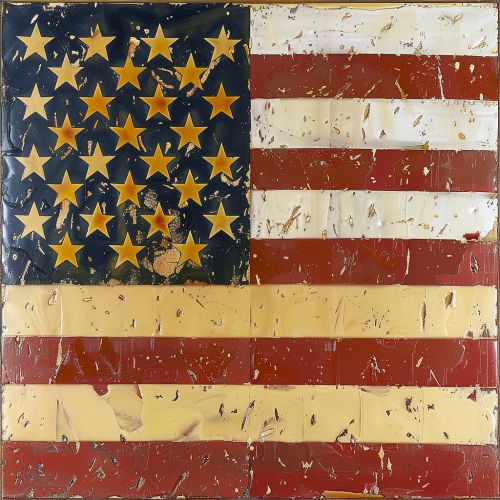Jasper Johns: Difference between revisions
(Created page with "== Early Life and Education == Jasper Johns was born on May 15, 1930, in Augusta, Georgia, and raised in South Carolina. His early life was marked by a series of relocations due to his parents' separation. Johns showed an early interest in art, which was encouraged by his aunt. He attended the University of South Carolina for three semesters, where he studied art. In 1949, Johns moved to New York City, where he briefly attended the Parsons School of Design. == Career B...") |
No edit summary |
||
| Line 11: | Line 11: | ||
One of Johns' most famous works is his series of paintings of the American flag. The first of these, simply titled "Flag," was created in 1954-55. This work is notable for its use of [[encaustic]], a technique involving hot wax and pigment, which gives the painting a textured, almost sculptural quality. The flag series challenged traditional notions of what constituted a painting, blurring the lines between art and object. | One of Johns' most famous works is his series of paintings of the American flag. The first of these, simply titled "Flag," was created in 1954-55. This work is notable for its use of [[encaustic]], a technique involving hot wax and pigment, which gives the painting a textured, almost sculptural quality. The flag series challenged traditional notions of what constituted a painting, blurring the lines between art and object. | ||
[[Image:Detail-79381.jpg|thumb|center|Jasper Johns' painting of the American flag, using encaustic technique.]] | |||
== Target and Number Series == | == Target and Number Series == | ||
Revision as of 06:42, 18 May 2024
Early Life and Education
Jasper Johns was born on May 15, 1930, in Augusta, Georgia, and raised in South Carolina. His early life was marked by a series of relocations due to his parents' separation. Johns showed an early interest in art, which was encouraged by his aunt. He attended the University of South Carolina for three semesters, where he studied art. In 1949, Johns moved to New York City, where he briefly attended the Parsons School of Design.
Career Beginnings
Johns' career began in earnest after his discharge from the U.S. Army in 1953. He returned to New York and became part of the burgeoning art scene. It was during this period that he met Robert Rauschenberg, a fellow artist who would become a significant influence and collaborator. Johns' early work was characterized by a departure from the dominant Abstract Expressionism of the time, instead focusing on everyday objects and symbols.
Flag Series
One of Johns' most famous works is his series of paintings of the American flag. The first of these, simply titled "Flag," was created in 1954-55. This work is notable for its use of encaustic, a technique involving hot wax and pigment, which gives the painting a textured, almost sculptural quality. The flag series challenged traditional notions of what constituted a painting, blurring the lines between art and object.

Target and Number Series
In addition to his flag series, Johns is well-known for his target and number series. These works continued his exploration of familiar symbols and objects. The target paintings, such as "Target with Four Faces" (1955), use concentric circles to create a sense of focus and repetition. The number series, including "Numbers" (1960), employs numerical sequences to explore themes of order and chaos.
Influence and Legacy
Johns' work has had a profound impact on the art world. His use of everyday objects and symbols helped pave the way for the Pop Art movement, influencing artists such as Andy Warhol and Roy Lichtenstein. Johns' work also prefigured the Conceptual Art movement, with its emphasis on ideas over aesthetics.
Later Works and Techniques
In the 1970s and 1980s, Johns continued to evolve as an artist. He began to incorporate more complex techniques and materials, including lithography and screen printing. Works from this period, such as "Catenary" (2001), show a continued interest in themes of perception and reality.
Awards and Recognition
Johns has received numerous awards and honors throughout his career. In 1988, he was awarded the Grand Prize at the Venice Biennale. He has also been the recipient of the Presidential Medal of Freedom and the National Medal of Arts. His work is held in major collections worldwide, including the Museum of Modern Art in New York and the Tate Gallery in London.
Personal Life
Johns has always been a private individual, rarely giving interviews or discussing his personal life. He has lived and worked in Connecticut since the 1990s. Despite his reclusive nature, Johns remains an active figure in the art world, continuing to produce new work and influence younger generations of artists.
See Also
- Robert Rauschenberg
- Pop Art
- Conceptual Art
- Encaustic Painting
- Lithography
- Screen Printing
- Museum of Modern Art
- Tate Gallery
